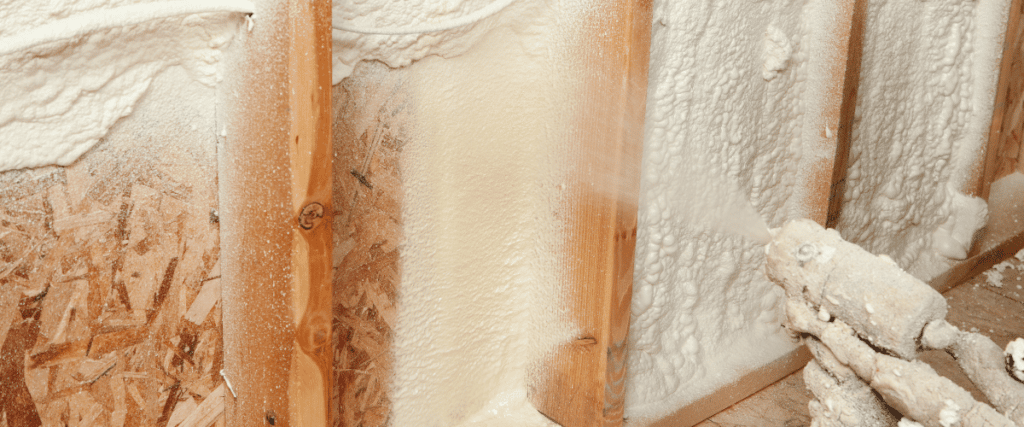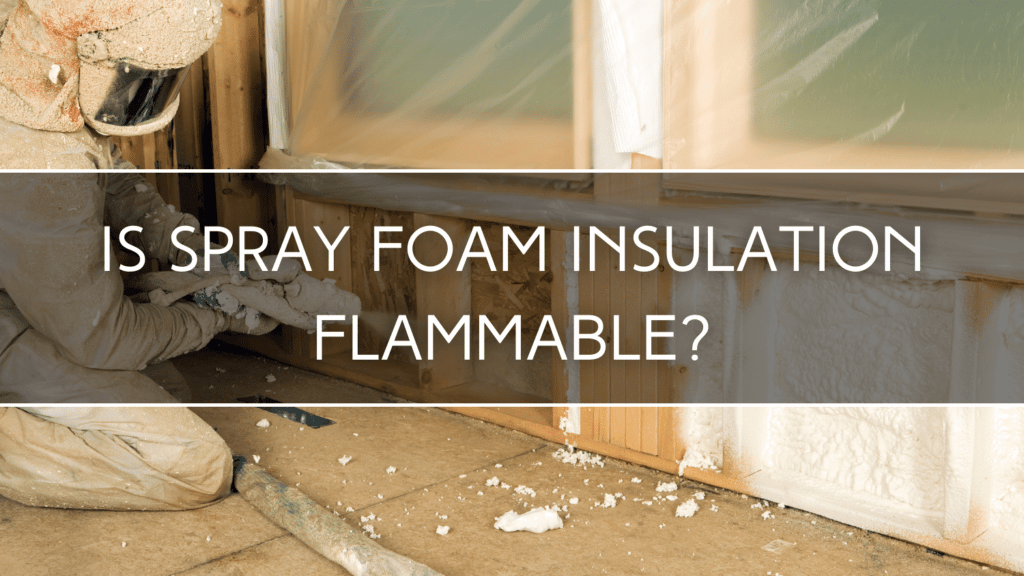Many people are discovering the extraordinary insulation capabilities of Spray-On Foam & Coatings. It seems that every year, more people discover how spray foam insulation can be used to insulate buildings and lower energy costs.
We are able to attest that, despite the reputation of fiberglass insulation not being very effective, some people are still shocked to discover there is an alternative. These people quickly realize how much more efficient spray foam insulation is than fiberglass. Spray foam insulation continues to gain popularity.
It is not the effectiveness of spray foam that people have questions about. Some, however, do have questions about the safety of the product. We will answer the question in the headline of this blog post: Is spray foam insulation flammable. So let’s get to the point.
Is spray foam flammable?
Spray foam, like many other materials in a building or home, can ignite and burn when exposed to a sufficient heat source. Foam insulation should always be treated as a combustible material and handled appropriately.
Of course, there are also going to be differences between open-cell and closed-cell spray foam insulation and fire resistance capabilities are no different.
According to the International Building Code, all Foam Plastic Materials (not just spray foam, but Styrofoam, soundproofing foams, extruded polystyrene, foam boards, etc.) must be considered flammable. Different foams from different manufacturers have different flammability. There are many foams available that exceed the International Building Code standards. Before a project can be started, it is important to read the documentation of each foam manufacturer.
Does it matter if my insulation is Flammable?
Yes, I do know. This is obvious. However, it is important to be aware of the dangers of insulation that could cause fire. Surprisingly, there are insulations which can reduce the spread of fire. Time is crucial in the event of an emergency.

What is the Difference between Fire Retardant & Fireproof?
It is important to consider the safety of the insulation material you choose for your home. Companies are convincing homeowners that inflammable insulation is the best. The truth is that insulation can be inflammable. The truth is that there is no insulation that is completely fireproof. There are also more details about how insulation reacts to fire. In a very short time, all insulations can become flammable. Don’t worry. There is a solution. Newer insulations can be made fire retardant. What is the difference?
The term fireproof (also known as fire resistance) refers to the ability of the substance to resist fire and is therefore inflammable. However, there isn’t any insulation on the market with such qualities. Yet.
Fire retardant is a substance that reduces the spread of fire. Preservatives in foam insulation can reduce the flammability and possibly reduce the rate at which the fuels burn.
How flammable spray foam?
Spray foam can ignite or burn when exposed to sufficient heat. It should therefore be treated with care. When ignited, spray foam can produce smoke, which can cause temporary blindness or unconsciousness.
Nearly all spray foam insulation that is available for purchase should contain flame retardant properties because untreated foam can be a fire accelerant.
The majority of foam insulation products on the market today are either expanded polystyrene or polyurethane foams, which are both made from petroleum derivatives. These foam products can burn rapidly if left untreated or exposed to flame and elevated temperatures.
Spray foam’s benefit is its ease of use and ability to perform heat and sound insulation. However, it can’t prevent fires as well as rockwool, which can withstand temperatures up to 1.000 degC.
This video shows spray foam and other insulation materials being set on fire.
Flame spread rating
The flame spread index measures the distance a flame travels on a substrate over a specified time period to determine its propensity for burning and spreading flames.
It is divided into three classes:
| Classes | Flame Spread Index |
| A | 0-25 |
| B | 26-75 |
| C | 76-200 |
- Class A fire ratings refer to a flame spread rating of between zero and 25. Brick, gypsum wallboard and fiber cement exterior materials fall under Class A or Class 1. These materials are not fireproof and will not light a fire.
- The flame spread rating for a Class B fire rating or Class 2 fire rating would be between 26 and 75. This rating is common for slower-burning wholewood materials such as planks, which are still in their original form when cut from the tree.
- A flame spread rating of between 76 to 200 is a Class C or 3 fire rating. This includes building materials such as plywood, fiberboard and hardboard siding panels as well as faster-burning whole woods.
What is a good flame spread rating?
The Flame Spread index is lower than the others. This means that flames won’t spread as quickly and travel farther. The safest materials are Class A materials. They have a rating between 0-25. They don’t burn well and are unlikely to fuel a fire.
Comparing spray foam to other insulation materials
Here is a table that shows the Flame Spread rating, smoke production and Sound Transmission Class of the most commonly used insulation materials (Spray foams, rockwools, fiberglass, Cellulose, and MLV).
Notice: The STC rating refers to which insulation material is best for a typical interior wall that has 1/2 inch of drywall. This wall has an STC rating 34 and the way it raises this rating.
| Material | Flame Spread Rating | Smoke Development | Sound Transmission Class |
| Spray foam | 75 | 450 | 39 for an open cell, 37 for a closed cell |
| Mineral wool (Rockwool). | 25 | 50 | 45 |
| Fiberglass | 25 | 50 | 39 |
| Mass Loaded Vinyl | 25 | 250 | 33 |
| Cellulose | 25 | 50 | 44 |
Spray foam is by far the most flammable of all insulation materials. Spray foam is flammable but has a 1-hour fire rating. This means that although it can burn, it can be exposed to flames for 1 hour without igniting.
Spray foam safety recommendations
- Spray foam should be applied by professionals only.
- Ventilate the room thoroughly to prevent propellant gas (methylene-diphenyl-diisocyanate 4,4) from building up inside the room, which may cause a fire or explosion.
- While foam is being applied or cured, ensure that there aren’t any naked flames such as candles, gas stoves or gas fires.
Conclusion
Spray foam is great for heat and sound insulation. It’s also easy to apply, as it fills every corner much faster than fiberglass or rockwool.
It’s also very flammable, and can release toxic smoke which can be very harmful to people.
That all being said, spray can be a perfectly safe choice if you use a class A spray foam and have it applied by professionals.

